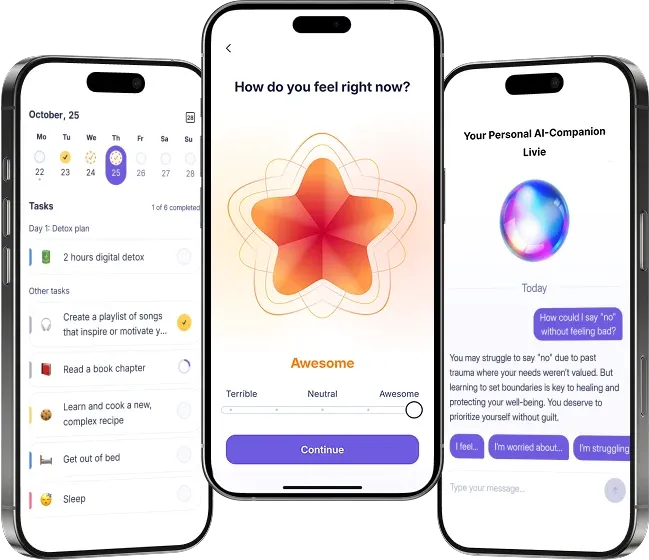8 Common Myths About Anxiety

First things first, there is a spectrum between casual anxious feelings and a diagnosed anxiety disorder.
Understanding common myths about anxiety is going to increase acceptance, promote the necessary coping practices, and encourage individuals to seek professional help should they notice that their worry has gone out of hand.
Admitting that "I'm just the worrier type" may simply pose a danger to one's long-term health. So this is what we are going to do: debunk the myths, quote credible sources, and invite the reader to give it a good thought.
Myth #1: Anxiety Isn’t a Real Disorder
It is okay to worry about things, and we often hear "I'm anxious about it" in colloquial speech, so what is the big deal?
The key to understanding any detrimental mental health condition is that, in general, it causes suffering. When it comes to generalized anxiety disorder (GAD), the severity of debilitating effects on a person's daily life might leave psychiatry professionals no other choice but to assign a respective pharmaceutical treatment. Commonly, psychiatrists would refer their patients to therapists as well, so that the underlying causes of anxiety could be detected.
Below are some of anxiety symptoms listed in Diagnostic and Statistical Manual (DSM-V):
- Restlessness or feeling keyed up or on edge.
- Being easily fatigued.
- Difficulty concentrating or mind going blank.
- Irritability.
- Muscle tension.
- Sleep disturbance (difficulty falling or staying asleep, or restless unsatisfying sleep).
According to the latest classification, panic disorders, certain phobias, social anxiety disorders, and some others go under the general name of "anxiety disorders". Anxiety is recognized as the most common mental disorder among American adults, so yeah, it's pretty real.
Myth #2: Anxiety Is Just Stress
Stress and anxiety are closely related but there is a good reason to distinguish them.
If one would alternatively call stress a tension or strain then the respective description of anxiety would be nervousness or jitteriness. Yet, no matter how many stressful situations there are, it does not necessarily cause anxiety disorders. Moreover, it is possible to feel stressed but not feel anxious or worried at the same time.
Stress, just like anxiety, is usually caused by external events or situations, e.g., difficult job or family circumstances, and the resolution of the situation immediately reduces stress. In the case of general anxiety disorder however, a person suffering from it will always find something to worry about, and should they start living a less stressful lifestyle, anxiety will stay.
Stress is more often related to something temporary. Anxiety, on the other hand, is persistent: if we keep the clinical definition of anxiety disorders in mind, excessive and uncontrolled worry must be present for more days than not over a span of more than 6 months.
Myth #3: People With Anxiety Are Weak
It takes a proper explanation to disprove this common misconception.
One of the possible mechanisms of anxiety disorder development is through early childhood abuse. In a stressful environment like that, children develop a habit of reacting to the world around them as threatening as a direct result of mistreatment. Their brain chemistry governs their relations for years on end until the habits in question are readdressed and changed. For that matter, it is not even appropriate to label people with anxiety sensitive, as you can see.
Neurodivergent children, for instance, are an easy target for scorn for their being different. The pressure they have to endure from their family members and peers compels them to build up character strength and resilience but also makes them prone to developing anxiety disorders.
Besides, you do not call people without anxiety blunt or stupid, do you?
Powering through the disorder along with its physical symptoms requires extraordinary self-discipline. So, those afflicted with anxiety disorders are anything but weak. Furthermore, the intent to seek professional treatment options shows great humility and self-awareness. Imagine the extent to which they can improve their everyday life as soon as they remove the detrimental symptoms.
Myth #4: Anxiety Will Go Away on Its Own
Expecting a mental health condition to go away on its own is a risky bet, to say the least. It is true that neuroplasticity and aging enable some people to heal over time, but is it really worth that to wait that long? Seeking professional treatment is strongly advised to treat anxiety disorders and stop them from wearing down the minds and bodies of those impaired: this is exactly what the right kind of support is meant for.
Without a doubt adopting a healthy lifestyle in general is crucial. For instance, there is a SEEDS acronym that stands for social support, education, exercise, diet, sleep, which outlines the respective life areas that must be focused on and improved for the sake of better mental health. These, however, should not be selected as the only treatment options. They may certainly alleviate the physical symptoms and give a person the much-desired respite, but a consistent, effective treatment would invariably involve professional examination and possibly, medication.
To be specific, here is what mental health professionals do:
- prevent false self-diagnosis;
- prevent ineffective and harmful self-treatment;
- help to judge if the disorder is due to a mental or physical condition;
- assist in developing mature defenses and responses to stress;
- ease the severity of the symptoms;
- stop the symptoms from worsening into self-harm, substance abuse, avoidant behavior, depression, panic attacks, and other issues.
The proper anxiety treatment will pay off in the long run.
Myth #5: Medication Is the Only Solution
The price of pharmaceuticals alone is enough to scare off anyone with limited income. It is a known fact that anxiety often goes hand in hand with depression, so imagine that now you are diagnosed with both and the go-to solution involves a class of medications known as serotonin-norepinephrine reuptake inhibitors (SNRI) or selective serotonin reuptake inhibitors (SSRI). Does it mean that you are hooked for a lifetime?
No, it doesn't. The role of medication is usually to stabilize a patient and free up their resources to reprogram the brain, as it were, to develop healthier responses. It is much like a painkiller and its role decreases as patients learn to self-regulate. To reiterate: one may opt out of the pharmaceutical treatment if they think they can handle the symptoms. However, if they are at the point of experiencing frequent panic attacks, intense fear, increased blood pressure, uncontrolled rapid breathing, irritable bowel syndrome, and the like – would they still refuse prescribed pharmaceutical treatment?
Another quick fact: pharmaceutical treatment of anxiety disorders is substantially more effective when paired with therapy. Namely, cognitive-behavioral therapy (CBT) is warmly regarded among mental healthcare professionals. Still, any of the two, picked alone, shows good results.
If the paycheck is of major concern, consider the following tips:
- Self-care (eating healthy and the such) is a necessary first step to reduce anxiety though its effectiveness is limited.
- Psychoeducation is invaluable but must be approached with care (when looking for answers, check the sources and add "research" to your search engine queries).
- Search for nearby anxiety self-help groups: it's a goldmine of experience and fun acquaintances!
- Ask around if your insurance package covers therapy.
- Look up organizations that provide free psychological consultation services.
The ultimate goal is to find a balanced approach, combining available resources to manage anxiety.
Myth #6: Avoiding Triggers Solves the Problem
In therapy, the key to healing most (if not all) mental health disorders is to approach the root of the issue – slowly and consciously, at the patient's own pace.
Avoidance actually makes anxiety worse. The case might be that somewhere at the core of an anxious person's mind there is a firm conviction that the source of their worry is entirely beyond their influence but at the same time it remains the source of imminent threat. Therapists may refer to these ideas as "limiting beliefs" or "all-or-nothing thinking". At first glance, there seems to be a deceptively simple solution: just act upon anxious thoughts or drop them altogether if they objectively exaggerate the scale of the issue. Naturally, the reasoning won't work and neither would avoidance.
The task is thus twofold. Increase the window of tolerance to stressful situations and direct the energy towards the source(s) of anxiety (basically to aim at resolving the problem at hand). Addressing anxiety disorders through systematic application of the ways we have described here (therapy, medication, self-help) is meant to do just that. In the meantime, past trauma, unhealthy thought patterns, or unresolved conflicts may emerge at the surface, ready to be reviewed and reevaluated. It must be admitted, however, that it is not possible to completely remove (only manage) certain conditions.
Myth #7: Children Can’t Experience Anxiety
Quite on the contrary, the traits of an anxious character start showing off early in life and gradually build up from there. The intensity of feelings in children is comparable to that in adults, and there is a danger of confusing the early anxiety disorder onset with normal behavior or mood swings.
We have already mentioned that toxic family environments contribute to the chances of anxiety development in children. It is not to say that children surrounded with compassionate care are safe from the disorder, as an individual child's constitution must never be discarded: one sibling may start developing the disorder, and the other, go on completely unaffected. The outcome is about a complex interplay between genetics, upbringing, and epigenetics: it is unpredictable.
For instance, children on the ADHD/autism spectrum tend to be picky and easily irritated by particular objects (toys, foods, textures...). The reaction of caregivers is paramount at this point. They should first be able to recognize those very special traits of the child or consider directing them for further diagnosis. Child therapists and psychiatrists are there for that matter.
Myth #8: Anxiety Only Emerges During Major Life Disturbances
Although we have used "anxiety" and "anxiety disorders" interchangeably throughout the text, we also did our best to make it clear that casually feeling worried or anxious in response to stressful situations is absolutely normal. In a healthy scenario, its magnitude will correspond to the importance of the situation. It serves a protective purpose; it identifies real and possible dangers and pushes us to react, adapt, and grow. It is a part of human experience after all.
One should never aspire to become a superhuman and get rid of the slightest signs of worry with over-the-counter sedatives.
So when does it actually cross the line and become a "disorder"? You would certainly feel the difference. In a nutshell, you'd notice that anxiety had lost its helpful purpose and started to work the other way around, like a burden, leading to the rise of the aforementioned symptoms.
It is easy to notice that something is wrong with excessive uncontrolled worry or irrational fear but it can't be stressed enough that only a certified professional can judge each individual case to determine the severity of disorder (along with its exact type) and assign the best treatment course. There are plenty of mental health disorders that partially resemble anxiety.
Conclusion
Anxiety disorders, taken together, are accountable for the highest number of diagnoses in population. Despite their relatively high prevalence, they can hardly be regarded as mild.
It is not a sign of weak willpower or thin-skinnedness. It cannot be just shrugged off. The toll it puts on one's health cannot be denied.
To begin with, acknowledge that anxiety can cross the threshold of a real illness.
The many misconceptions, shame, and social stigma can prevent people from reaching out to professionals and getting the help they need in time, which is why it is important to know the anxiety myths and facts.
Unfortunately, there is no single one-size-fits-all solution to effectively cure anxiety because patients have varying degrees of susceptibility or preference to psycho- and pharmacotherapy. Still, it is manageable through a valid combination of therapy, medication, and lifestyle changes. Given enough time and the right treatment, it will recline into a lengthy remission, leaving a person free to live their life with fewer worries.

